A complete comparison of the most popular hospital Portering Chairs of 2024
In this article we look at the world of portering chairs, sometimes called transit chairs or portering wheelchairs.
There are several portering chairs on the market today, which all look similar on paper, but in reality, each chair has different positive and negative features.
So, in this article, we attempt to provide an unbiased review of these chairs, uncovering the positives and negatives of each, and then leave you to make up your mind.
Bristol Maid Portering Chair
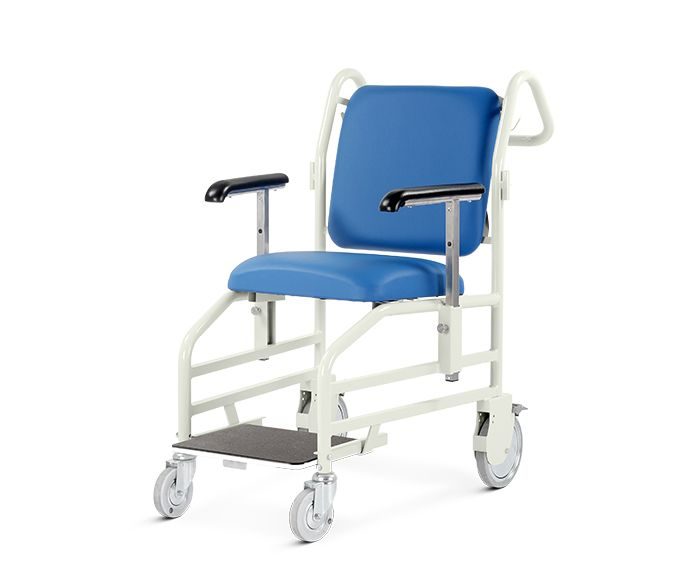
The Bristol Maid is a basic, heavy-duty portering chair, which can be supplied as rear or front steer, and with an option of sliding footrest or folding footrests.
Pros of the Bristol Maid
- Heavy-duty construction – The simple, robust design of the Bristol Maid means there are fewer things to go wrong with it, and maintenance costs are likely to be lower.
- Variety of configurations available – Depending on your requirements, the Bristol Maid can be supplied as a front or rear steering chair, and with a sliding one-piece footrest or folding footrests.
- Nesting feature – Reduces floor space and encourages tidy storage
- Drop-down armrests – This feature allows side access and easy transfers for patients, porters, and nursing staff.
- Document holder as standard – A handy feature, allowing the storage of any notes and patient records.
Cons of the Bristol Maid
- Outdated design – Some customers don’t like the outdated, ‘clinical’ look of the Bristol Maid chair, making them go with a more modern-looking option like the TransitFlow, Roma, or Stryker chairs.
- Small rear wheels – At 200mm, the fixed castors are smaller than the TransitFlow’s, which can make the chair harder for porters to push, particularly when pushing heavier patients.
- Upright seat – The seat angle is rather upright on the Bristol Maid, which some patients may find uncomfortable, particularly if they are being pushed over long distances.
- No integrated storage for patient belongings
- Independent braking – Each of the rear wheels on the Bristol Maid has its own brake, making braking the chair slower when compared to a chair with dual braking, such as the TransitFlow
- No fixed IV pole – The IV pole on the Bristol Maid is secured with a thumb screw, making it susceptible to being removed and lost.
- Handles are low – We’ve had feedback that the handles can be too low for staff to push comfortably.
Is there a bariatric version of the Bristol Maid Chair?
Yes, there is a bariatric Bristol Maid Portering Chair, which has a safe working load of 380kg.
What options are available for the Bristol Maid Portering Chair?
- Calf leg support
- IV pole holder
- Card/coin lock
- Lap-belt
- Cylinder holder
Roma Medical Woburn Portering Chair
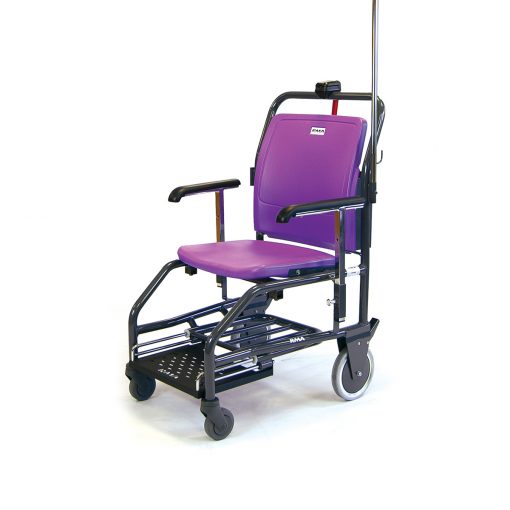
Pros of the Roma Chair
- Heavy-duty construction – Manufactured in Great Britain, the Roma Chairs are built to be sturdy and reliable.
- Folding armrests – This feature allows side access and easy transfers for patients, porters, and nursing staff, and is easier to operate compared to drop-down armrests.
- Nesting feature – Reduces floor space and encourages tidy storage
- Drop-down armrests – This feature allows side access and easy transfers for patients, porters, and nursing staff.
- Sliding footrest – The sliding footrest is a better alternative to folding footrests, allowing easy transfers.
Cons of the Roma Chair
- Upright – Like the Bristol Maid chair, patients find the Roma chair too upright, which can be uncomfortable.
- Plastic seat as standard – Similarly, the seat is made of hard, unpadded plastic, which doesn’t offer as much comfort for patients as the other chairs on this list.
- Sliding footrest construction – We’ve had feedback recently that the way the sliding footrest is made causes it to get stuck over time, which can cause difficulties for both porters and patients.
- Unreliable brakes – We’ve also had feedback from a hospital that the brakes will still allow the chair to move when there is a heavy patient being pushed on the chair.
- Storage area design – The storage area under the seat unfortunately allows for belongings and notes to fall between the bars, which isn’t a great design!
Is there a bariatric version of the Roma Portering Chair?
Yes, Roma Medical sell a portering chair called the Burleigh Bariatric, which has a safe working load of 318kg.
What options are available for the Roma Portering Chair?
- Document holder
- IV Pole
- Coin lock
Stryker Prime TC Transport Chair
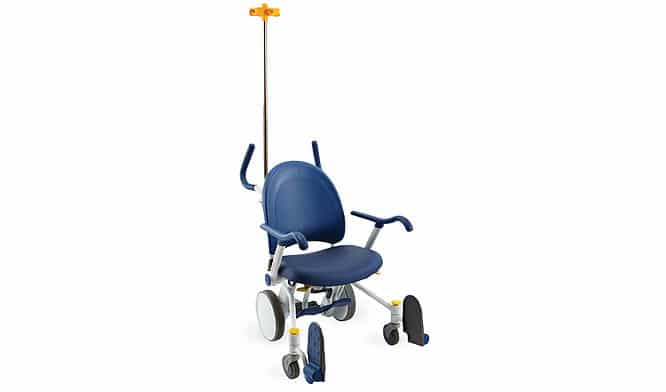
Pros of the Stryker Chair
- Modern design – The attractive design of the Stryker Prime TC will bring a touch of modernity to your hospital.
- Large rear wheels – The chair is always in a braked position until the push handle is depressed, helping to prevent falls and making it easier for porters to operate.
- Folding armrests – This feature allows side access and easy transfers for patients, porters, and nursing staff, and is easier to operate compared to drop-down armrests.
- Power-washable design – Excellent for infection control, the Stryker chair is power-washable.
Cons of the Stryker Chair
- Too leant-back – We’ve had feedback that the design of the seat is too leant-back, which can make transfers difficult for patients.
- Plastic seat as standard – To accommodate the power-washable design, the Stryker chair comes with a plastic seat as standard, which can be uncomfortable for patients. However, a padded seat is available as an optional extra.
- Wide footrests – The folding footrests are rather wide, which, needless to say, is not ideal for frail patients or patients wearing hospital gowns.
Is there a bariatric version of the Stryker Chair?
No, Stryker doesn’t make a bariatric version of their portering chair.
What options are available for the Stryker Chair?
- Leg supports
- Upright O2 tank holder
- Chrome-plated, 1” (2.5 cm) thick IV pole
- IV pole topper available in six colour options
- Foley bag hooks
- Padded seat
- Lap belt
Acime Manchester 3 Portering Chair
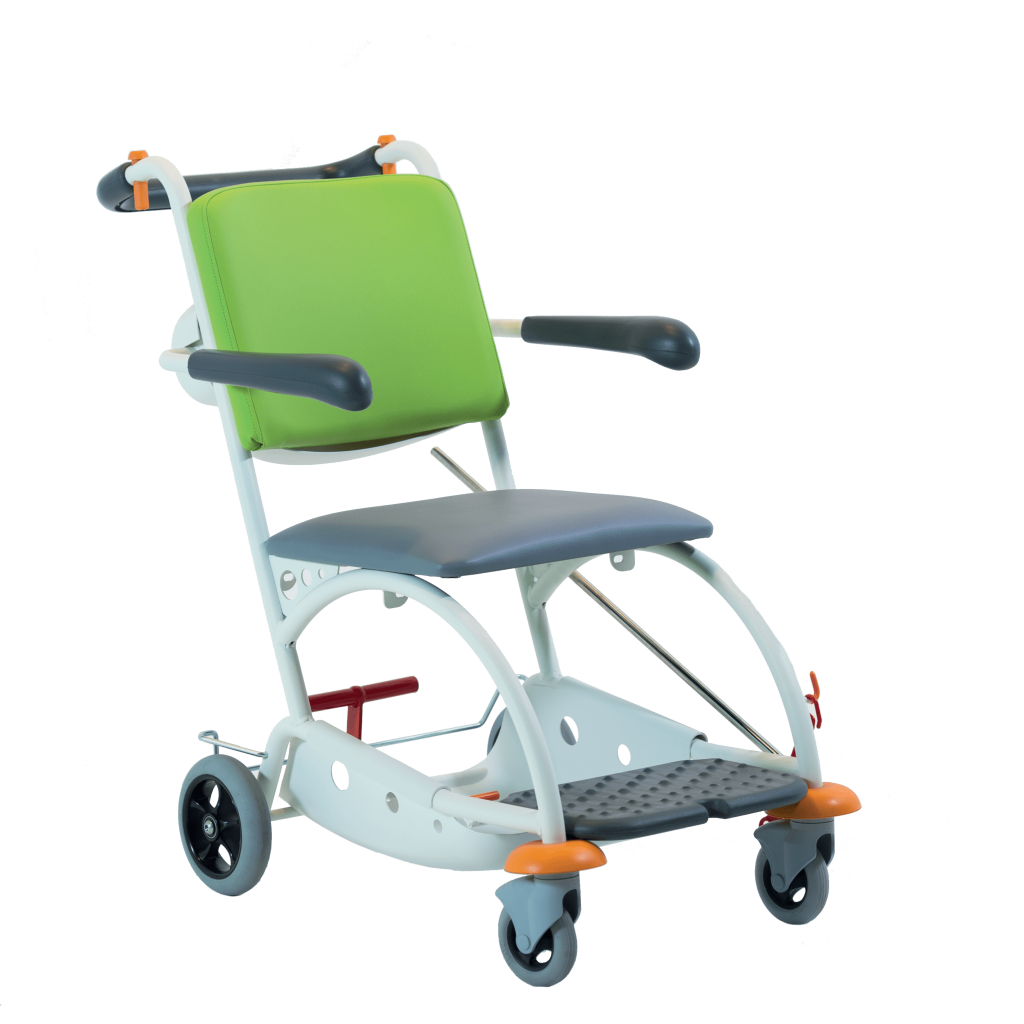
Pros of the Acime Manchester 3
- Lightweight and easy to manoeuvre – The lightweight design makes the Acime chair easy for porters to manoeuvre and push.
- Folding armrests – This feature allows side access and easy transfers for patients, porters, and nursing staff, and the folding design is easier and quicker to use compared to drop-down rests
- Folding footrest – The folding footrest is easy and quick for patients and porters to use and folds out of the way for easy transfers.
- Protective bumpers – These handy bumpers help protect the frame and paintwork from bumps and scratches.
Cons of the Acime Manchester 3
- Poor parts availability – Acime a France-based manufacturer, and spare parts are reported to be difficult to obtain, which can slow down repair times and reduce your available fleet.
- Not stackable – No nesting feature means the Acime chairs will take up more storage space when not in use.
Is there a bariatric version of the Acime Chair?
Yes, the bariatric version is called the Acime Manchester Heavyweight and has a safe working load of 329kg.
What options are available for the Acime Chair?
- IV Pole
- Coin Deposit Slot (£1 coin) i.e. Shopping Trolley Locking System
- Key Locking Slot
- Chain and Wall Mounted Attachment for Coin Deposit Slot
- ABS Plastic Compartment for Patient’s Items
- Document Holder for Rear of Chair
- Adjustable Orthopedic Leg Rest with Support
- Support for Orthopedic Leg Rest (each)
- Oxygen Bottle Holder Under the Seat
- Urine Pouch Hook
- Anti-theft Device for IV Pole
- 2 Hooks for Anti-theft Devices
- 2 Hooks and Chain for Lateral Leg Rest
- Non-standard Cover
TransitFlow Portering Chair
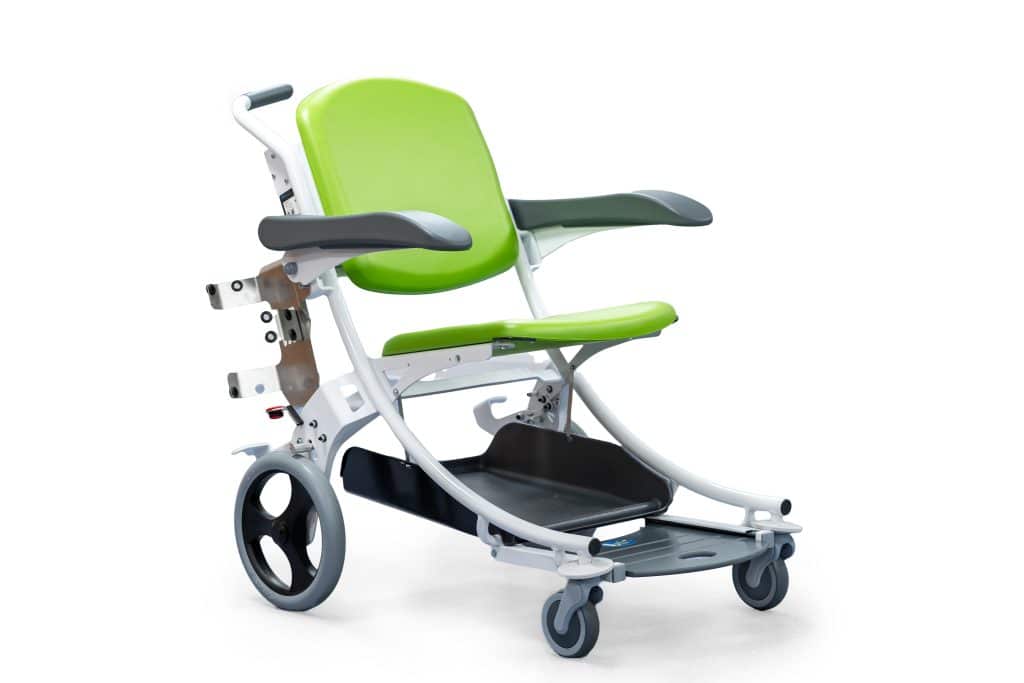
Designed for hospital use, the TransitFlow Portering Chair enables patients to be transported safely and comfortably in situations where a patient stretcher is unnecessary.
Pros of the TransitFlow Chair
- Modern & attractive design – The attractive design of the TransitFlow will bring a touch of modernity to your hospital
- Folding armrests – This feature allows side access and easy transfers for patients, porters, and nursing staff, and the folding design is easier and quicker to use compared to drop-down rests
- Sliding footrest – The auto-locking sliding footrest is an easier alternative to folding footrests and can be stood on with the chair tipping, allowing easy transfers.
- Large rear wheels – 300mm rear wheels allow the chair to be more easily pushed compared to chairs with small wheels and castors.
- Integrated document and belongings holders
- Nesting feature – Encourages tidy storage and maximises storage space.
Cons of the TransitFlow Chair
- IV Pole isn’t fixed – This could lead to the IV pole going missing or being displaced easily. There is also an option of purchasing the TransitFlow with a fixed IV pole to remedy this issue.
Is there a bariatric version of the TransitFlow Portering Chair?
Yes, the TransitFlow Bariatric has a safe working load of 250kg.
What options are available for the TransitFlow Portering Chair?
- IV pole (removable or fixed)
- Anti-static system
- Anti-theft system
- Accessory basket
- Cylinder holder
- Leg rest
- Coin lock (for coin or specific token)
- Wall fixation
- Bag hooks
Summary
Hopefully, this article has served to explain some of the key differences between each portering chair and educate the reader as to what to look for. Ultimately the best judge for this is you though, and there’s no better way to form a judgement than to try the equipment in your hospital.
Felgains are exclusive suppliers of the TransitFlow Portering Chair, and we offer the option for you to trial it in your hospital – please get in touch with us to arrange.
Get in touch
Got a question or want to send us a message? Let’s talk.
